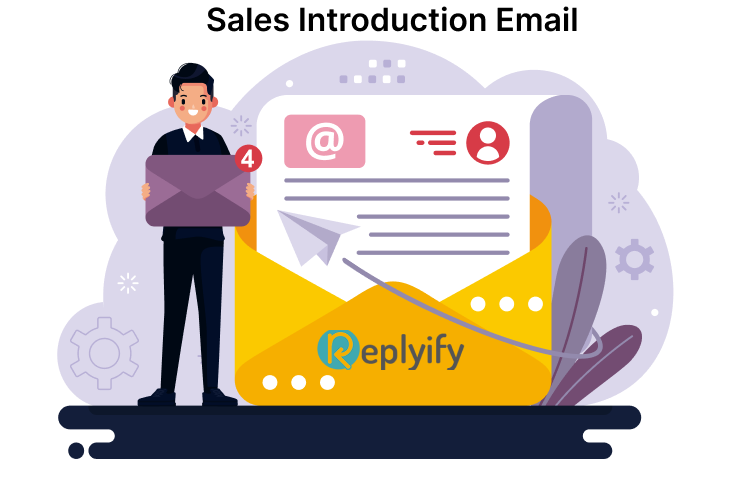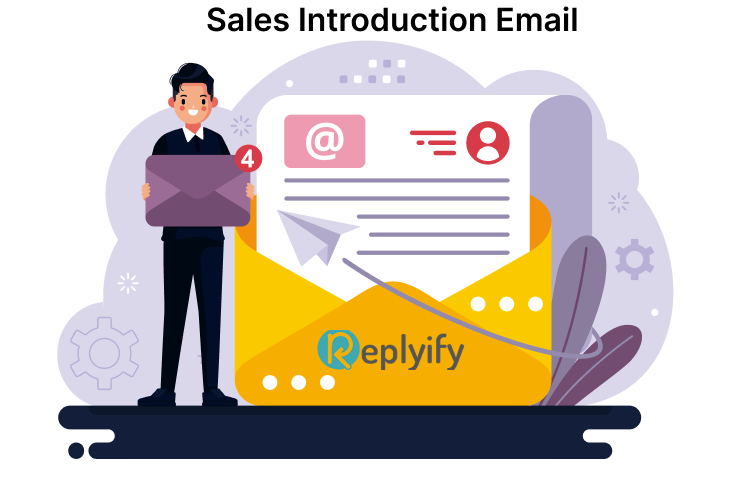How To Write a Sales Introduction Email

A sales introduction email may seem like a daunting task. You must entice your reader to open the email and persuade them to buy your product.
With the amount of junk mail in our spam folders today, this email seems impossible to pull off. Thankfully, with the help of a few tips and tricks, you can write a professional sales introduction email that achieves your sales goals.
This article will delve into the basic outline of a sales introduction email, followed by some tips on how to make your email grammatically perfect and tricks on getting clients to open your email.
Cold Email Subject Line Headline
Treat your sales introduction email like a traditional sales introduction letter. The headline often makes or breaks your case; this draws your reader in to continue reading or drives them away.
Like the headline in a sales introduction letter, the subject line in a sales introduction email will be your first chance to persuade your reader to continue.
Draw Your Reader In
Pretend the subject line is a hook. Too little bait and the fish won’t bite. Too much bait and the bait won’t fit in their mouths.
Attract your reader with an easy-to-read subject line. Keep it between five and seven words, and try to pique your reader’s interest.
Some eye-catching example subject lines include:
- Question about (recent event)
- (Mutual) recommended I get in touch
- I found you through (mutual’s name)
- We have (insert here) in common
Some of the most powerful cold email subject lines are personalized ones. Don’t be afraid to name-drop a mutual contact or divulge a common link you might share. This will cause you to jump out from other emails and make your reader want to continue.
Words To Avoid
One problem you may run into is spam folders. Algorithms have been perfected to recognize certain keywords. Once those words are detected, your email will find itself inside a spam folder, never to be seen again.
To avoid this untimely fate for your email, there are some keywords you should never include. Doing so will certainly send your sales introduction email to a spam folder.
Some keywords to avoid include:
- Final
- Reminder
- Sale
- Specials
- Complimentary
- Unique
- Discount
- Solution
- Tempting
Remember, you want your email to stand out, and there’s no better way to do that than to create a new, unique subject line that’s all your own creation.
Introduction – Cold Email
The introductory paragraph might seem trivial to some, but it remains a crucial part of the sales introduction email. Taking the time to polish your introductory paragraph saves you the sting of failure later on.
Intro and Greeting
The greeting can often be tricky. Who exactly are you addressing? Sometimes you can’t tell if it’s a man or woman.
When you are sure the person you’re addressing is a man, use “Mr.” in your greeting. However, when it comes to women, things get weird. Use “Mrs.” with married women and “Ms.” with unmarried women. If you don’t know their marital status, use “Ms.”
However, sometimes it’s best to stick to the company, such as “Good morning (Company name)” or “Hello (title of the person you’re addressing).”
Company Blurb
In a sales introduction email, you’re introducing yourself, your product, and your company. Directly after the greeting, you should place a short blurb about your company directly after the greeting.
This doesn’t need to be a long, winding set of three paragraphs. Just a short couple of sentences explaining what your company is all about. Don’t forget to include your mission statement!
An example company blurb could run something like this:
“(Greeting)
My name is (your name), and I work for Joe’s Garden Emporium. Here at Joe’s, we’re committed to creating a greener, cleaner planet. Today, I hope to speak to you about our new wedding process.”
Main Body of Cold Email
You get down to business in the main body. Here you sell your product as best you can. Your reader has made it this far, and now it’s time to persuade them to buy your product.
Establish Credibility
Chances are, you aren’t the only company out there selling that particular product. So what makes you different from other companies?
An excellent way to answer this question is by establishing credibility. Show the client why they should trust you and your product instead of someone else’s.
Talk about how long you’ve been in business, your company reviews, any sort of awards, or anything that shows your company knows what they’re doing.
An example way to establish credibility would be:
“Joe’s Garden Emporium has been recognized nationwide for its first-rate customer service, winning the Excellence in Customer Service Award two years in a row. We take pride in ensuring our customers have a great experience with us.”
Don’t be afraid to brag about yourself a bit, but also keep it truthful!
Pose a Problem
One of the best ways to quickly show how useful a product you sell is to show how easily it can solve your customers’ problems.
One good way to do this would be to do some research concerning your customers. For example, what problems do they face daily, and how can your product help fix them?
A way to a pose a problem would be:
“As a homeowners association, one of your biggest concerns is ensuring your neighborhoods remain clean. Sidewalks free of weeds, yards without dandelions, and clean flower beds show that your association cares about homeowners.
Here at Joe’s, we’re committed to keeping Earth green and clean. So how do you effectively keep your neighborhood weed-free without hurting our planet by using harmful chemicals?”
Offer a Solution via Your Product
Now that you have shown the issue, it’s time to illuminate the answer. Demonstrate how your product effectively solves your customer’s problem without creating extra hassle.
One way to offer a solution:
“Joe’s Garden Emporium believes in a cleaner, greener earth so much that we created our own weed killer made of natural oils.
Harmful chemicals found in most weed killers hurt our planet by destroying local ecosystems and hurting the atmosphere. Joe’s Weed-Away was made with natural oils that get the job done without hurting our beautiful Earth.”
Connect to the Customer
While some customers might enjoy reading paragraphs about how great your product is, the vast majority will not. Thus, you must consistently connect back to the customer.
If you know what their goals as a company are, use them. Always refer back to their problems. Remember, this sales introduction email is about them. Constantly connecting with the client, whether their goals or issues, reiterates that.
Entice Your Reader
Now that they understand what your product is and how it helps them, it’s time to sell. This would be a good time to entice them to buy your product. Mention any special deals or prices you have.
Notice how you have waited to disclose your deals and prices until now? This keeps your email out of spam folders, but more importantly, it allows you to establish a more personal connection with your potential client.
Tactics vary, but an example way to entice potential clients would be:
“Joe’s Garden Emporium would like to establish a relationship with you as your prime weed killer supplier. We’d like to offer you a bulk load of Joe’s Weed Away for the low price of $16. If you’re unsatisfied, we’ll be happy to give you a 100% refund.”
Closure
When closing out your sales introduction email, it’s essential to leave your client with an excellent final impression. Therefore, there’s no need to go over the pricing again, as you should have done so earlier in the main body. Instead, keep it short and sweet.
Call to Action
The most obvious call to action would be to ask them to buy your product, but you have to be more subtle.
One good call to action would be:
“Contact me at (details) if you’d like to build this relationship with us or if you have any questions.”
Another would be:
“Thank you for taking the time to read this email today. Please don’t hesitate to reach out to (details) if you have any questions.”
Decisive Statement
Despite being polite, closing with a simple “thank you” isn’t at all decisive. Instead, it sounds waffling and timid.
End with something like “I look forward to speaking with you” or “I look forward to our professional relationship.”
These final statements show confidence, and that’s crucial in sales.
Showing confidence with your potential client will further reinforce your credibility. Clearly, you’re confident in how this product will help them, and that will cause them to think the same.
Tips for a Well-Written Message
Now that we’ve run through the outline, it’s time to discuss the actual writing of your sales introduction email.
Nothing is more of a turn-off than reading a poorly written email that is grammatically incorrect. So in this next section, we’ll talk about how to polish your sales introduction email.
Templates
Word provides templates for a sales introduction email, as do multiple sites on the Internet. These templates can be helpful if your sales introduction email needs better formatting.
However, it’s important to incorporate your personal style in these emails. If you want a good relationship with your potential client, avoid using too many internet templates.
Using these templates says you don’t have the time to create your own email from scratch, and the client doesn’t matter as much to you.
Grammar and Punctuation
Grammar and punctuation are vital to creating an easy-to-read sales introduction letter. Using programs like Grammarly won’t just correct spelling and punctuation mistakes; they’ll also help make your email easier to read.
Even if you’re confident with grammar and spelling, use a program or a proofreader to help you catch small mistakes. Remember, all the time and effort you put into your email shows the client how much you care about them and their business.
Clear, Concise Language
Your sales introduction email should be to the point. Do your best to omit the fluff and unnecessary words.
It’s also a good idea to avoid using passive voice. An example of a sentence in the passive voice would be: “Joe’s Garden Emporium is the best producer of weed killer.”
Change that sentence to something like “Joe’s Garden Emporium manufactures the best weed killer.”
Omitting words like “is” and “are” keeps your writing in the active voice. Passive voice will sound less decisive and confident.
Bullet Points
Don’t be afraid to use bullet points!
There’s nothing worse than opening a document and scrolling through miles of dense text. Use white space whenever possible. This means using bullet points.
Bullet points are good to use when you’re listing something, whether it’s reasons why your product is sustainable or the price ranges for various product sizes.
Opening Emails
When it comes to clients opening emails, you want to ensure your email opening rate is high. There are a few ways you can confirm this.
- Send emails in the morning. Most people open their emails then, and you want to ensure your email is at the top of their feed.
- Keep specific keywords and phrases out of your subject line. This keeps your email out of spam folders.
- Create engaging content people will want to open.
Conclusion
Establishing credibility and a relationship with your client remains vital. Therefore, while sales introduction emails follow a specific template, you may certainly change some details to fit your own style.
Utilizing white space and bullet-point lists makes your email easy to read. In addition, ensuring correct grammar and punctuation while avoiding passive voice gives your sales introduction email a nice flow.
The most important thing to remember is to put yourself in your potential clients’ shoes. They have a problem, and they want it solved. Use your sales introduction letter as an opportunity to help them by selling your product and creating a long-lasting professional relationship with them.

